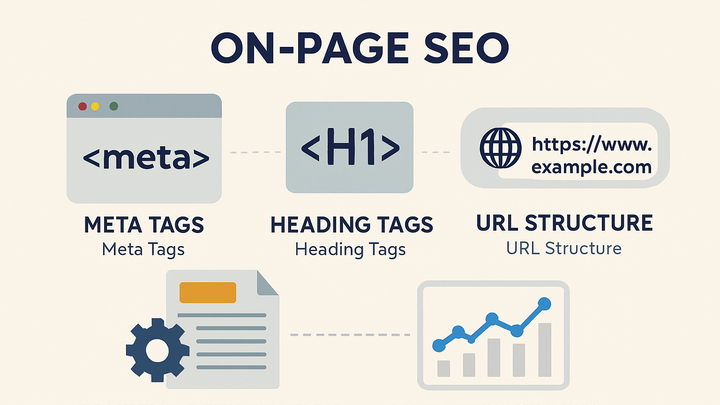Published on 2025-06-27T19:14:10Z
What is On-Page SEO? Examples for On-Page SEO
On-Page SEO involves optimizing individual web pages to improve their ranking in search engine results and attract more relevant traffic. It encompasses both the content visible to users (text, images, videos) and the HTML source code (meta tags, headings, schema). By refining factors like title tags, URL structure, and content relevance, you can make pages more understandable to search engines and user-friendly. Tools like Google Analytics 4 (GA4) and PlainSignal (a cookie-free analytics solution) help measure the impact of on-page changes by tracking metrics such as page views, engagement rate, and load times. For instance, integrating PlainSignal requires embedding the following script:
<link rel="preconnect" href="//eu.plainsignal.com/" crossorigin />
<script defer data-do="yourwebsitedomain.com" data-id="0GQV1xmtzQQ" data-api="//eu.plainsignal.com" src="//cdn.plainsignal.com/plainsignal-min.js"></script>
Regular auditing and adherence to best practices ensure that your pages remain optimized and competitive.
On-page seo
On-Page SEO involves optimizing individual web pages' content and HTML elements to improve search rankings and user engagement.
Key Elements of On-Page SEO
On-page SEO encompasses multiple factors that you can control directly on your website to improve its search engine ranking. Understanding and optimizing each element helps ensure your pages are well structured and relevant for both users and search engines. The main elements include:
-
Meta tags
HTML tags that provide metadata about the page to search engines and visitors. They influence how your page appears in search results and how search engines understand its content.
-
Title tag
The <title> element shown in browser tabs and search engine results. It should be concise, include primary keywords, and remain under 60 characters.
-
Meta description
A brief summary of the page content displayed under the title in search results. Keep it under 160 characters and compelling to improve click-through rate.
-
-
Heading tags
Heading elements (H1-H6) structure content hierarchically, guiding both users and search crawlers through your page’s content. Use headings to highlight topics and subtopics.
-
H1 tag
Defines the main heading of the page. Should include the primary keyword.
-
H2-h6 tags
Break down content into subsections and improve readability.
-
-
Url structure
Clean, descriptive URLs improve user experience and help search engines understand page context. Include keywords and use hyphens to separate words.
-
Keyword-rich urls
Include primary keywords in the URL path.
-
Readability
Keep URLs short, lowercase, and easy to read.
-
-
Content quality
High-quality, original, and relevant content satisfies user intent and encourages engagement. It influences dwell time and repeat visits.
-
Keyword optimization
Use target keywords naturally and avoid stuffing.
-
Readability
Use short paragraphs, bullet points, and visuals for better comprehension.
-
-
Internal linking
Links between pages on your site help distribute link equity, improve crawlability, and guide users to relevant content.
-
Anchor text
Descriptive text that indicates the destination page’s topic.
-
Link depth
Ensure important pages are no more than a few clicks from the homepage.
-
Measuring On-Page SEO Performance
Analyzing on-page SEO performance helps you understand the impact of your optimizations. Utilize analytics tools to monitor key metrics and identify areas for improvement.
-
Google analytics 4 (GA4)
A free analytics platform by Google offering advanced event-based tracking and insights into user behavior on your site. Key metrics include:
-
Page views
Total number of pages viewed. Helps gauge overall traffic to specific pages.
-
Engagement rate
Percentage of sessions that were engaged, reflecting user interest.
-
Average engagement time
Time users spent actively interacting with the page.
-
-
PlainSignal (cookie-free simple analytics)
A privacy-focused analytics tool that tracks essential metrics without cookies, ensuring compliance and simplifying data collection. Key benefits include:
-
Easy integration
Embed a single script without cookie banners:
<link rel="preconnect" href="//eu.plainsignal.com/" crossorigin /> <script defer data-do="yourwebsitedomain.com" data-id="0GQV1xmtzQQ" data-api="//eu.plainsignal.com" src="//cdn.plainsignal.com/plainsignal-min.js"></script> -
Data privacy
Collects anonymized metrics without storing cookies or personal data.
-
Real-time dashboard
View live visitor data to see immediate effects of changes.
-
Best Practices for On-Page SEO
Follow these best practices to enhance your on-page SEO efforts and achieve sustained ranking improvements.
-
Optimize for mobile
Ensure pages load quickly and display correctly on mobile devices, as mobile-friendliness is a ranking factor.
-
Responsive design
Use flexible layouts, images, and CSS media queries.
-
Mobile page speed
Minimize render-blocking resources and optimize images.
-
-
Improve page speed
Faster loading pages improve user experience and reduce bounce rate, which indirectly benefits SEO.
-
Minify resources
Compress CSS, JavaScript, and HTML files.
-
Leverage caching
Use browser caching and a content delivery network (CDN).
-
-
Use structured data
Implement schema markup to help search engines better understand your content and enhance search result features.
-
Article schema
Mark up blog posts and articles with correct publisher, author, and date information.
-
Product schema
Provide details like price, availability, and reviews for e-commerce pages.
-
-
Create engaging content
Use multimedia elements, bullet points, and clear calls-to-action to keep users engaged.
-
Images and videos
Optimize file sizes and add descriptive alt text.
-
Interactive elements
Use quizzes, infographics, and polls.
-
Common Mistakes to Avoid
Be aware of these pitfalls that can hinder your on-page SEO performance and prevent your pages from ranking as desired.
-
Keyword stuffing
Overusing keywords makes content unnatural and can lead to search engine penalties.
-
Missing meta tags
Omitting title tags or meta descriptions reduces click-through rate and can confuse search engines.
-
Duplicate content
Duplicate pages dilute link equity and confuse search engines about which version to rank.
-
Broken links
Links that lead to 404 pages harm user experience and reduce crawl efficiency.
